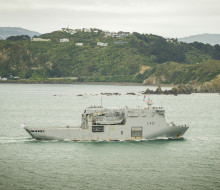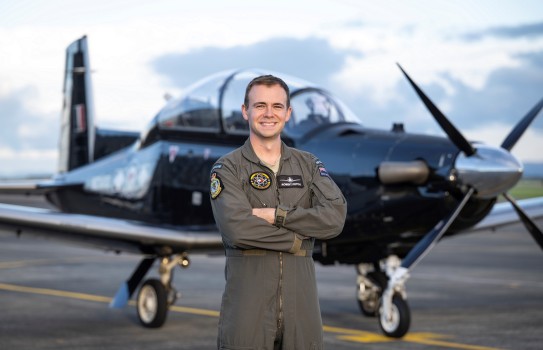
HMNZS Canterbury’s fourth capital visit this year highlights ship’s critical Defence role
29 August 2025
Unfortunately you are viewing this website on an outdated browser which does not support the necessary features for us to provide an adequate experience. Please switch to a modern browser such as latest version of Google Chrome, Mozilla Firefox, Apple Safari or Microsoft Edge.
Ngā mihi nui
The Royal New Zealand Air Force’s (RNZAF) T-6C Texan II fleet has reached a milestone with 40,000 flying hours – roughly equivalent to flying non-stop for four and a half years.
Since its introduction in 2015, the aircraft have been central to the RNZAF’s pilot training programme at No. 14 Squadron and are also flown by the Black Falcons aerobatic team.
Since the Texans’ arrival, 97 pilots have successfully earned their brevets. Of those, 91 were from the RNZAF and Royal New Zealand Navy, and six were from the Royal Australian Air Force.
Flight Lieutenant Corey Fothergill was on the first course, learning to fly the Texans in 2016. A decade on he is now an instructor on the same course.
Flight Lieutenant Corey Fothergill graduating as one of the first pilots to train in a T-6C Texan II
“It’s definitely a full-circle sort of moment, which is cool,” Flight Lieutenant Corey Fothergill says.
Recalling the moment he first sat in a Texan as a beginner pilot was “overwhelming”.
“It's a very powerful training aircraft for someone who hadn't done flying before. It was a humbling moment.”
Flight Lieutenant Fothergill went from the Texans to flying NH90 helicopters with No. 3 Squadron, which provided career highlights including flying in Australia and Solomon Islands, as well as being involved in search and rescues around the country.
“But being back at No. 14 Squadron for the past six months has been really rewarding.”
One of the squadron’s latest graduates, Flying Officer Robert Petch, received his Wings in June.

Flying Officer Robert Petch, one of the latest pilot graduates.
He described flying the aircraft as “learning to drive in a sports car”.
“No. 14 Squadron takes you from having zero aviation experience to navigating at 250 feet at speeds of 210 knots [389km/h].”
Ensuring the pin was pulled from his seat to enable ejection in case of an emergency was a sobering moment on his first flying day, Flying Officer Petch said.
The new pilot will now put his lessons into practice, also as an instructor at No. 14 Squadron, before moving to a frontline squadron in a couple of years.
Reaching 40,000 flying hours for the fleet was impressive and reflected the large number of sorties – about 18, but up to 24 – scheduled each day, he said.
Officer Commanding No. 14 Squadron, Squadron Leader Simon Isemonger said the serviceability rates of the aircraft were among the highest in the world.
“We've worked through several significant issues over the past 10 years that have been resolved by an amazing team.”
The aircraft was ideal as a training plane with its modern flight deck and multi-function displays, he said.
“It also has pretty decent range to get around New Zealand so that the pilots can experience what we have to offer at home in terms of different locations.
“It offers a broad spectrum of flying disciplines, preparing pilots well for their future employment on New Zealand Defence Force operational fleets, and also provides a capable platform for display flying by the Black Falcons.”
This milestone also highlights the strength of the squadron’s international partnerships with Textron Aviation Defence, for providing the training aircraft, engineering, and logistical support; Airbus, for ensuring fleet readiness through maintenance and support; and CAE, for delivering and taking care of the simulation and training systems.